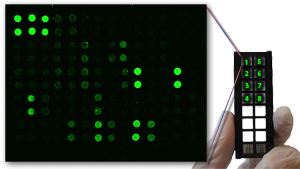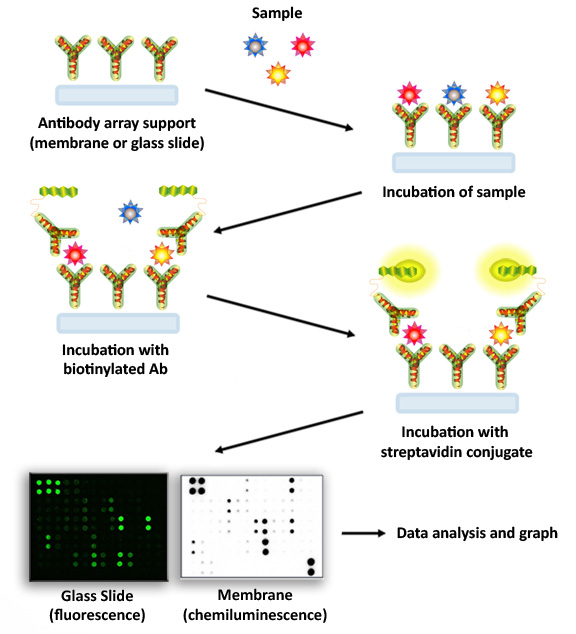Semi-Quantitative, Sandwich-based, Glass Slide Antibody Arrays
Antibody arrays allow researchers to conduct rapid, accurate expression profiling of hundreds of cytokines, chemokines, growth factors, proteases, soluble receptors and other proteins from any biological fluid.
RayBio® Glass Slide-based Antibody Arrays (G-Series) were introduced as a “second generation” array platform after the chemiluminescent membrane arrays (C-Series). The G-Series uses a 75mm x 25mm glass chip platform which delivers easier handling along with the use of much lower sample volumes.
The glass slides also utilizes a fluorescent signal readout, allowing a wider dynamic detection range than can be achieved by chemiluminescence. G-Series Antibody Arrays are particularly well-suited for projects with very limited sample volumes (as little as 10 μl per array) and large numbers of samples. Dozens of arrays can be processed per day by a single technician. Furthermore, the slide chamber assembly is compatible with many automated array processing systems, allowing high-throughput studies to be performed with very little hands-on time.
Please contact Genomax for the walk-through of the technology.

Features
- More Data, Less Sample: G-Series Antibody arrays provide high-content screening using less sample volume than ELISA. Only 50 µl needed (after dilution) to detect up to 40 different biomarker proteins. As little as 10 µl original sample!
- Global View of Cytokine Expression: Antibody array screening improves the chances for discovering key factors, disease mechanisms or biomarkers related to cytokine signaling.
- Greater Sensitivity: As little as 4 pg/ml of MCP-1 can be detected using the G-Series array format. In contrast, our similar MCP-1 ELISA assay has a sensitivity of 40 pg/ml of MCP-1.
- Increased Range of Detection: ELISA assays typically detect a concentration range of 100- to 1000-fold, however, RayBiotech arrays can detect IL-2 at concentrations of 25 to 250,000 pg/ml, a range of 10,000-fold.
- Better Precision: As determined by densitometry, the inter-array Coefficient of Variation (CV) of spot signal intensities is 5-10%, comparing favorably with ELISA testing (CV = 10-15%).
How It Works
G-Series Antibody Arrays utilize the sandwich-ELISA design principle. In this assay, capture antibodies are printed in multiple identical arrays on a standard-sized histology slide. After a blocking step, samples are incubated with the arrays. Nonspecific proteins are then washed off, and the arrays are incubated with a cocktail of biotinylated detection antibodies, followed by a streptavidin-conjugated fluor. Signals are visualized using a fluorescence laser scanner.

Publications cited RayBio Antibody Arrays
- Blansfield JA, Caragacianu D, Alexander RA III, Tangrea MA, Morita SY, et al. Combining Agents that Target the Tumor Microenvironment Improves the Efficacy of Anticancer Therapy. Clin Cancer Res. 2008; 14(1):270-280.
Species: Human
Sample Type: Cell Lysate - Liu D., et al. SIX1 Promotes Tumor Lymphangiogenesis by Coordinating TGF? Signals That Increase Expression of VEGF-C . Cancer Res; Published OnlineFirst August 20, 2014; doi:10.1158/0008-5472.CAN-13-3598
Species: Human
Sample Type: Conditioned Media - Jose S., Hughbanks ML., Binder BY., Ingvale GC., Leach JK. Enhanced trophic factor secretion by mesenchymal stem/stromal cells with Glycine-Histidine-Lysine (GHK)-modified alginate hydrogels. Acta Biomater. 2014 May;10(5):1955-64. doi: 10.1016/j.actbio.2014.01.020
Species: Human - Ando, Yuji, Akihito Yamamoto, and Kohki Matsubara. "Stem Cell-conditioned Medium Accelerates Distraction Osteogenesis through Multiple Regenerative Mechanisms." Bone. ScienceDirect, 02 Jan. 2014. Web.
Species: Human
Sample Type: Conditioned Media - Brunt KR., et al. Ex Vivo Akt/HO-1 Gene Therapy to Human Endothelial Progenitor Cells Enhances Myocardial Infarction Recovery. Cell Transplant. 2012;21(7):1443-61.
Species: Human
Sample Type: Cell Lysate - Sugano G., Bernard-Pierrot I., Lae M., Battail C., Allory Y., Stransky N., et al. Milk fat globule?epidermal growth factor?factor VIII (MFGE8)/lactadherin promotes bladder tumor development. Oncogene (2011) 30, 642-653;
Species: Mouse
Sample Type: Tissue Lysate - Owens P, Pickup MW, Novitskiy SV, et al. Disruption of bone morphogenetic protein receptor 2 (BMPR2) in mammary tumors promotes metastases through cell autonomous and paracrine mediators. Proceedings of the National Academy of Sciences of the United States of America 2012;109(8):2814-2819. doi:10.1073/pnas.1101139108.
Species: Mouse
Sample Type: Tissue Lysate - Bobrie A., Krumeich S., Reyal F., et al. Rab27a supports exosome-dependent and -independent mechanisms that modify the tumor microenvironment and can promote tumor progression. Cancer Res. 2012 Oct 1;72(19):4920-30. doi: 10.1158/0008-5472.CAN-12-0925
Species: Mouse
Sample Type: Conditioned Media - Pequeuz C., Raymond-Letron I., Blacher S., et al. Stromal Estrogen Receptor-a Promotes Tumor Growth by Normalizing an Increased Angiogenesis. Cancer Res. 2012 Jun 15;72(12):3010-9. doi: 10.1158/0008-5472.CAN-11-3768
Species: Mouse
Sample Type: Tissue Lysate - Roth W., Kumar V., Beer HD., et al. Keratin 1 maintains skin integrity and participates in an inflammatory network in skin through interleukin-18. J Cell Sci. 2012 Nov 15;125(Pt 22):5269-79. doi: 10.1242/jcs.116574
Species: Mouse
Sample Type: Cell Lysate - Roth W., Kumar V., Beer HD., et al. Keratin 1 maintains skin integrity and participates in an inflammatory network in skin through interleukin-18. J Cell Sci. 2012 Nov 15;125(Pt 22):5269-79. doi: 10.1242/jcs.116574
Species: Mouse
Sample Type: Conditioned Media - Cyclophilin D Extramitochondrial Signaling Controls Cell Cycle Progression and Chemokine-Directed Cell Motility
Species: Mouse
Sample Type: Conditioned Media - IGF1 Receptor Signaling Regulates Adaptive Radioprotection in Glioma Stem Cells
Species: Mouse
Sample Type: Conditioned Media - Palmi C., et al. Cytoskeletal Regulatory Gene Expression and Migratory Properties of B Cell Progenitors are Affected by the ETV6-RUNX1 Rearrangement Mol Cancer Res molcanres.0056.2014; Published OnlineFirst July 24, 2014; doi: 10.1158/1541-7786.MCR-14-0056-T
Species: Mouse
Sample Type: Conditioned Media - Pavlides S., et al. Caveolin-1 regulates the anti-atherogenic properties of macrophages. Cell Tissue Res (2014) 358:821-831. DOI 10.1007/s00441-014-2008-4
Species: Mouse
Sample Type: Conditioned Media - Labelle M., et al. Platelets guide the formation of early metastatic niches. PNAS published online July 2014. www.pnas.org/cgi/doi/10.1073/pnas.1411082111
Species: Mouse
Sample Type: Conditioned Media - Matsushima Y., et al. An Atopic Dermatitis-Like Skin Disease with Hyper-IgE-emia Develops in Mice Carrying a Spontaneous Recessive Point Mutation in the Traf3ip2 (Act1/CIKS) Gene. J Immunol. 2010 Aug 15;185(4):2340-9. doi: 10.4049/jimmunol.0900694.
Species: Mouse
Sample Type: Serum - Vulesevic B., Mcneill B., Geoffrion M., Kuraitis D., McBane J., et al. Glyoxalase-1 overexpression in bone marrow cells reverses defective neovascularization in STZ-induced diabetic mice. Cardiovascular Research (2014) 101 (2): 306-316. doi: 10.1093/cvr/cvt259
Species: Mouse
Sample Type: Tissue Lysate - Huang Y., et al. Met-CCL5 represents an immunotherapy strategy to ameliorate rabies virus infection. Huang et al. Journal of Neuroinflammation 2014, 11:146. doi:10.1186/s12974-014-0146-y
Species: Mouse
Sample Type: Tissue Lysate





